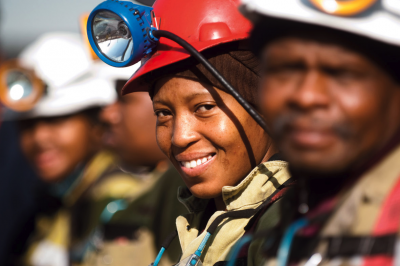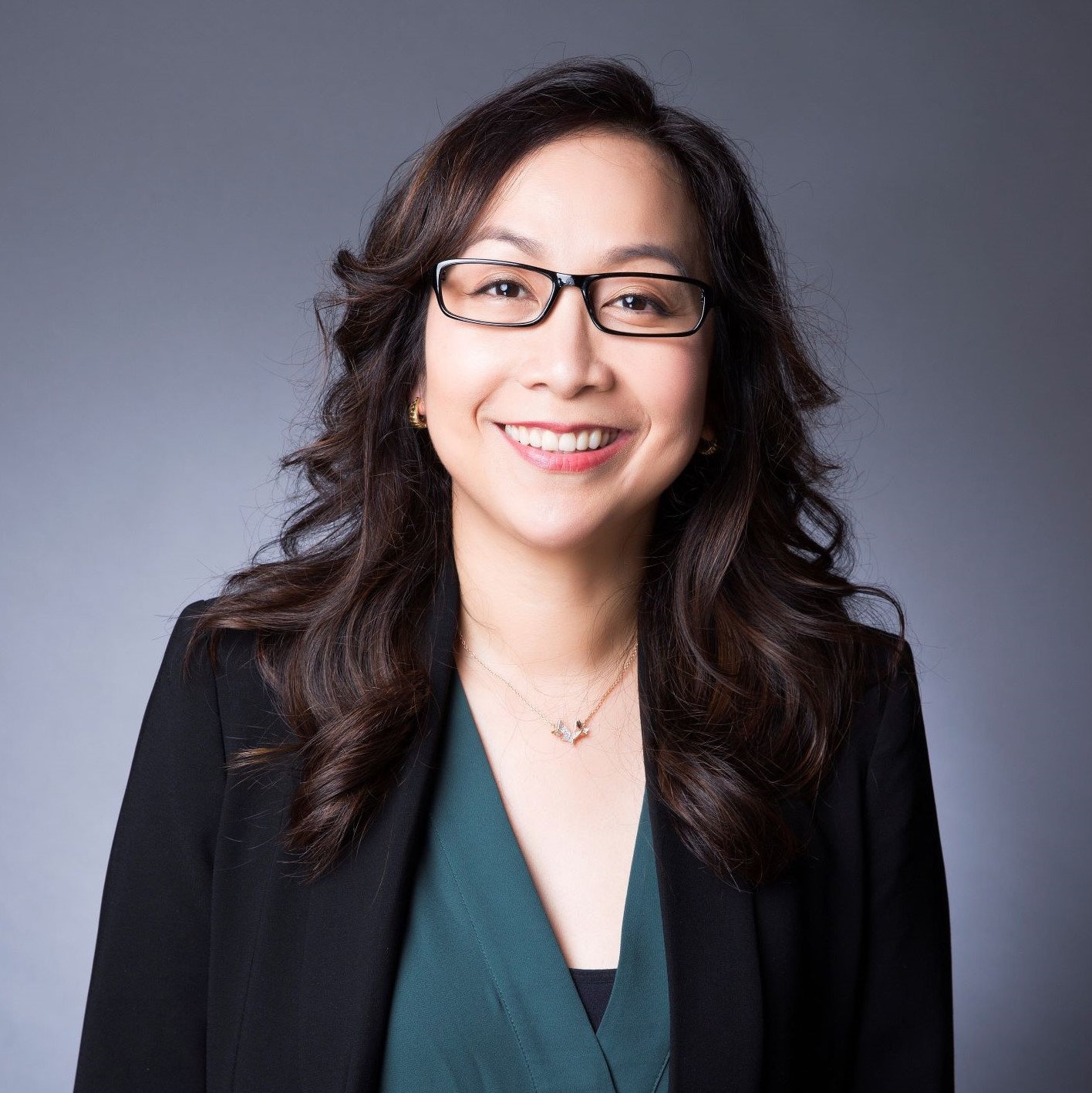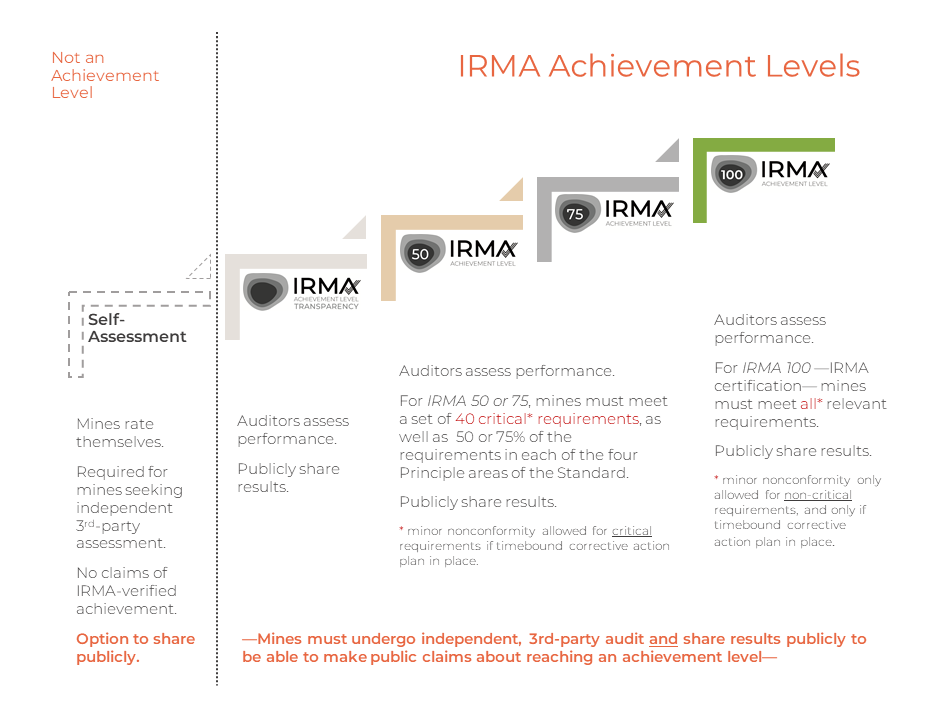Companies such as those in jewelry, electronics, building and auto sectors want assurance that the minerals they buy are mined responsibly. Civil society organizations and communities expect adherence to a standards system that is comprehensive, robust and accountable to all affected stakeholders.
IRMA seeks to drive positive change in industrial-scale mining using credible third-party assessment: a tool that has been proven to deliver better social and environmental outcomes in industries such as agriculture, forestry and fishing. IRMA offers the only third-party assessment of industrial-scale mine sites for all mined materials that is governed equally by the private sector, local communities, civil society, and workers. It is the most comprehensive standard and is available now for mines all over the world.


Our long-standing collaboration with the Initiative for Responsible Mining Assurance has given us the opportunity to partner and address important and challenging issues in the mining sector across the areas of ethics, labor, human rights, health and safety, and the environment.Ephi Banaynal dela Cruz
Senior Director, Responsible Sourcing, Microsoft
More information about Microsoft’s implementation of the Microsoft Devices Responsible Sourcing of Raw Materials policy, including its commitments, approach and progress, is available here.
IRMA Assessment Fundamentals
IRMA assesses performance of mine sites. Here are some important facts about our assurance program:
- It is the mine site, not the company, that gets assessed.
- A mining company can choose to commit to putting a percentage of its mines into the program, or reach a verified performance level at all of its mines, and make claims about that commitment and achievement.
- We use a step-by-step approach: starting with self-assessment, and followed by independent third-party assessment and public reporting on performance.
- Our robust, independent audits include desk review and on-site visits to every mine that applies for assessment, as well as stakeholder engagement in the assessment process.
- It is not a pass/fail certification system. Our Standard describes ‘best practice’ for mines globally but also encourages mines at any level to come in and be recognized for continuously improving (see IRMA achievement levels, below).
- Independent assessment results, including verified IRMA achievement levels, are valid for 3 years from the date the audit report is finalized — after which point the assessment cycle begins again.
IRMA Achievement Levels
All mines coming into the IRMA system begin with a self-assessment. It is only through an independent, third-party assessment and the publication of audit results that achievement is recognized in by IRMA.
There are four achievement levels in the IRMA system. The first level, called IRMA Transparency, requires only that mines be audited by an IRMA- approved audit firm and release their results publicly.
The IRMA 50, IRMA 75 and IRMA 100 levels reflect increasingly higher levels of performance across the four sections of the IRMA Standard (Business Integrity, Planning for Positive Legacies, Social Responsibility and Environmental Responsibility). At the 50, 75 and 100 levels of achievement, mines must also meet a set of critical requirements, although at IRMA 50 and IRMA 75 some minor non-conformity is allowed as long as there is a corrective action plan to reach full conformity within 18 months. To reach IRMA 100, all of the critical requirements must be fully met.
For more detailed information and the assessment process and IRMA achievement levels, read the Assessment Manual for Mines.


There needs to be a high bar, which is why all mines should follow the safeguards outlined in IRMA's Standard for Responsible Mining. We call on companies around the world to ensure the products they buy from mines meet these standards.Michael Brune
Former Executive Director, Sierra Club
Start your assessment journey today
In most cases, a mine site assessment will cover a single mine site and any associated operations that are co-located within the site boundaries (e.g., milling, concentrating, smelting, waste disposal, etc.).
While IRMA leaders believe that a site-specific approach is critical to understanding impacts at the local level, they also realize that mining operations come in myriad forms, and as a result, assessing individual mine sites may not be the best approach in all cases.
For example, there may be several mining operations (underground, open pit or a mix) accessing an ore body, with the mined ore feeding into a common set of processing facilities. In cases where mining-related activities are interconnected and in close proximity, and are owned and/or operated by the same company, it may make more sense to assess all operations at the same time to ensure that the cumulative impact of the entire complex on the local environment and communities is taken into consideration. Such an approach can help to reduce audit costs, and also reduce the time burden on both mines and stakeholders who may want to participate in audit processes.
There may be other situations, however, where mines feed into a common mineral processing facility, but the mines are located geographically distant from each other. Even though they may be part of the same mineral supply chain, the impacts of each mine site are unique (i.e., the environment and communities affected by each mine are distinct, each site has its own workforce, etc.).
IRMA will work mines to determine the appropriate scope of an assessment, and the scope will be included in audit announcements and other public information about the assessments so that stakeholders have a clear understanding of what operations and facilities will be assessed. If any stakeholder believes that the scope of an assessment is likely to result in issues or impacts being overlooked or missed, they have the opportunity to provide that input to IRMA through our complaints and grievance process.
FOR MORE INFORMATION:
- Read the IRMA’s Issues Resolution System procedure
- Contact the IRMA Secretariat to find out how to request an exception: info@responsiblemining.net
The first step in the assessment process is for mines to conduct a self-assessment using our Mine Measure self-assessment and audit preparation tool.
The Mine Measure tool can also be used by any mine that is interested to see how its practices compare with the Standard for Responsible Mining. In 2021, all mining companies are being offered one free use of the self-assessment tool.
Completing a self-assessment is a powerful way to signal to stakeholders that mines plan to deliver on their promises.
Why use the audit preparation tool to self-assess?
- Identify gaps in environmental or social performance
- Reassure buyers and clients
- Improve engagement with communities
- Prepare for, and save time and money during, the independent audit
FOR MORE INFORMATION:
- Visit the Mine Measure website.
- Download the latest version of the Mine Measure Instruction Manual (English, French, Portuguese, Spanish) for information on the tool, and its functionality.
- View a webinar on the self-assessment tool by going to the Webinars page of the website.
IRMA is the only multi-stakeholder-governed standards system that offers third-party independent assessment at the site of the industrial mine and for all mined materials (except energy fuels). IRMA meets mines where they are, at any place in their journey to make improvements. We independently verify the steps in a mine’s journey towards more responsible mining, and offer customer-facing claims along the way. To learn about the process from start to finish, read our Assessment Manual for Mines.
Mine sites can start by being audited and disclosing their results publicly (IRMA Transparency). Some mines will go beyond and show they are meeting IRMA’s set of critical requirements, and additional multi-stakeholder-developed requirements. As their performance improves mines can get recognition for reaching the IRMA 50, IRMA 75 and IRMA 100 achievement levels.
In mid-2019 we began our auditing program of mine sites against version 1.0 of the Standard for Responsible Mining. Visit our Mine Sites Under Assessment page to view mines currently undergoing 3rd-party audits.
Mines that wish to undergo independent assessment should begin by filling out the Mine Site Assessment Application Form.
In most cases, the assessment will cover a single mine site and any associated operations that are co-located within the site boundaries (e.g., milling, concentrating, smelting, waste disposal, etc.). IRMA will work mines to determine the appropriate scope of an assessment, and the scope will be included in audit announcements and other public information about the assessments so that stakeholders have a clear understanding of what operations and facilities will be assessed. If any stakeholder believes that the scope of an assessment is likely to result in issues or impacts being overlooked or missed, they have the opportunity to provide that input to IRMA through our stakeholder complaints process.
If mining companies are unsure whether their mines are ready for an independent audit, they are encouraged to start with a self-assessment through our ‘Mine Measure‘ tool and to publicly share their intentions.
IRMA is working with SCS Global Services and ERM Certification and Verification Services (ERM-CVS) as its first audit program partners. Both SCS and ERM-CVS have experience auditing social, environmental and technical issues at industrial-scale mines. Interested mines should contact our approved Audit Firms directly to request a bid, or find out more about their services:
ERM-CVS: Will Huggett will.huggett@ermcvs.com
SCS Global Service: Susan Courter scourter@scsglobalservices.com
FOR MORE INFORMATION:
- View our Resources for Mines
- Write to us at info@responsiblemining.net.
Self Assessment Fees
A company’s first use of the Mine Measure self-assessment tool is free. The fee for each additional company site to use the tool is $2,500 per operation. However, costs should not be a barrier to access the tool. IRMA will consider requests for fee reductions.
Independent Assessment Fees
A company undergoing independent assessment contracts with and pays fees to both an IRMA-approved independent audit firm, and IRMA itself. The cost associated with performing the independent assessment is determined by the audit firm, in conjunction with the site, based on scope, site complexity, and other considerations. Learn more in the Assessment Manual for Mines.
IRMA’s Administration Fee Policy falls into four tiers based on mine site revenue/turnover (average of most recent 3 years). The fee may be paid annually to IRMA – first when the mine applies for independent assessment, and each subsequent calendar year; or mines may pay for 3 years and receive a 5% discount (paid when the mine applies for independent assessment, and when reassessment commences). All costs below are in U.S. dollars.
| Annual site revenue | Annual fee | 3-year payment (5% discount) |
|---|---|---|
| < $100 million | $3,750 | $10,687 |
| $100 million – $500 million | $6,750 | $19,237 |
| $500 million – <$1 billion | $8,750 | $24,937 |
| > $1 billion | $10,750 | $30,647 |
Buying mined materials that originate from mines engaged in IRMA gives value to companies that seek to offer a responsible value chain to their customers. In 2019, more than 60 civil society organisations have come forward publicly and called for companies to source mined materials from mines that meet IRMA’s Standard for Responsible Mining.
Purchasers can demonstrate their commitment and make contact with mines working towards certification by joining IRMA as a member, and make a commitment to sourcing from responsible mines. They can then encourage their suppliers to engage with IRMA. Membership also offers many benefits including participation in our multi-stakeholder governance. Purchasers receive tools to help them source from responsible mines and to help them create appropriate incentives for mines to enter the IRMA system.
Read more on how mining companies and purchasers can engage in IRMA.
